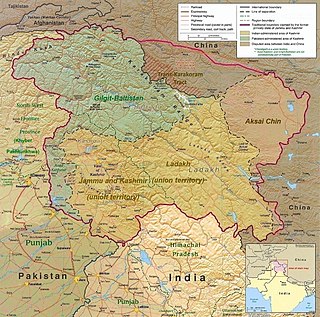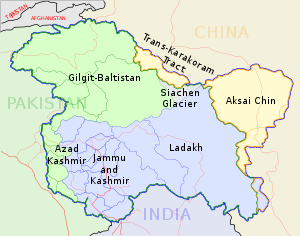
Jammu and Kashmir was a region formerly administered by India as a state from 1954 to 2019, constituting the southern and southeastern portion of the larger Kashmir region, which has been the subject of a dispute between India, Pakistan and China since the mid-20th century. The underlying region of this state were parts of the former princely state of Jammu and Kashmir, whose western districts, now known as Azad Kashmir, and northern territories, now known as Gilgit-Baltistan, are administered by Pakistan. The Aksai Chin region in the east, bordering Tibet, has been under Chinese control since 1962.

Since the partition of British India in 1947 and creation of dominions of India and Pakistan. The two countries have been involved in a number of wars, conflicts and military stand-offs. The Kashmir issue and across the border terrorism have been the cause of conflicts between the two countries mostly with the exception of the Indo-Pakistani War of 1971 where conflict originated due to turmoil in erstwhile East Pakistan.

The Dassault Mirage 2000 is a French multirole, single-engine fourth-generation jet fighter manufactured by Dassault Aviation. It was designed in the late 1970s as a lightweight fighter to replace the Mirage III for the French Air Force. The Mirage 2000 evolved into a multirole aircraft with several variants developed, with sales to a number of nations. It was later developed into the Mirage 2000N and 2000D strike variants, the improved Mirage 2000-5 and several export variants. Over 600 aircraft were built and it has been in service with nine nations.

Jaish-e-Mohammed is a Pakistan-based Deobandi jihadist Islamic Jihadis group active in Kashmir. The group's primary motive is to separate Kashmir from India and merge it into Pakistan. Since its inception in 2000, the terror outfit has carried out several attacks in the state of Jammu and Kashmir. It projects Kashmir as a "gateway" to the entire India, whose Muslims are also deemed to be in need of liberation. After liberating Kashmir, it aims to carry its ‘jihad’ to other parts of India, with an intent to drive Hindus and other non-Muslims from the Indian subcontinent. It has carried out several attacks primarily in the Indian state of Jammu and Kashmir. It also maintained close relations with Taliban and Al-Qaeda in Afghanistan and continues to be allied with these groups.

The insurgency in Jammu and Kashmir is an uprising or revolt against the Indian administration of Jammu and Kashmir, a region constituting the southern portion of the larger Kashmir region, which has been the subject of a dispute between India and Pakistan since 1947.

Balakot is a town in Mansehra District in the Khyber Pakhtunkhwa province of Pakistan. The town was destroyed during the 2005 Kashmir earthquake, but was later rebuilt with the assistance of the Government of Pakistan and Saudi Public Assistance for Pakistan Earthquake Victims (SPAPEV), a Saudi relief organisation.
Masood Azhar is the founder and leader of the Pakistan-based terrorist organisation Jaish-e-Mohammed, active mainly in the Pakistani-administered portion of the state of Jammu and Kashmir. On 1 May 2019, Masood Azhar was listed as an international terrorist by United Nations Security Council.
The 2001–2002 India–Pakistan standoff was a military standoff between India and Pakistan that resulted in the massing of troops on either side of the border and along the Line of Control (LoC) in the region of Kashmir. This was the second major military standoff between India and Pakistan following the successful detonation of nuclear devices by both countries in 1998, with the first being the Kargil War of 1999.
On Monday, 1 October 2001, three militants belonging to Jaish-e-Mohammed carried out an attack on the Jammu and Kashmir State Legislative Assembly complex in Srinagar using a Tata Sumo loaded with explosives, ramming it into the main gate with three fidayeen suicide bombers. 38 people and three fidayeen were killed in this attack.

Ilyas Kashmiri, also referred to as Maulana Ilyas Kashmiri and Muhammad Ilyas Kashmiri, was a senior al-Qaeda operative and leader of the Harkat-ul-Jihad al-Islami (HUJI). He was also connected with the Soviet–Afghan War, the Kashmir conflict and attacks against India, Pakistan and the United States. In August 2010, the US and the United Nations designated him a terrorist. NBC News reported that United States officials had mentioned him as a possible successor to Osama bin Laden as head of al-Qaeda. Prior to his death, a CNN News headline called him the "most dangerous man on Earth", while the late journalist Syed Saleem Shahzad said of him that "he is invariably described by the world intelligence agencies as the most effective, dangerous, and successful guerrilla leader in the world."
The General Dynamics F-16 Fighting Falcon has served the United States and the air arms of 25 other nations. Over 4,400 F-16s have been sold.

This is a list of aviation-related events from 2014:
There have been several attacks on Indian Armed Forces by militants in 2016.

On 29 September 2016, India announced that it conducted "surgical strikes" against militant launch pads across the Line of Control in Pakistani-administered Kashmir, and inflicted "significant casualties". Indian media reported the casualty figures variously from 35 to 70. Partial footage of the strikes was released to the Indian media on 27 June 2018 as proof to the strike.
Iran–Israel conflict during the Syrian Civil War refers to the Iranian-Israeli standoff in and around Syria on the course of the Syrian conflict. With increasing Iranian involvement in Syria from 2011 onwards, the conflict shifted from a proxy war into a direct confrontation by early 2018.

On 14 February 2019, a convoy of vehicles carrying security personnel on the Jammu Srinagar National Highway was attacked by a vehicle-borne suicide bomber at Lethpora in the Pulwama district, Jammu and Kashmir, India. The attack resulted in the deaths of 40 Central Reserve Police Force (CRPF) personnel and the attacker. The responsibility for the attack was claimed by the Pakistan-based Islamist militant group Jaish-e-Mohammed. The attacker was Adil Ahmad Dar, a local from Pulwama district, and a member of Jaish-e-Mohammed. India has blamed Pakistan for the attack. Pakistan condemned the attack and denied any connection to it.

The 2019 Balakot airstrike was conducted by India in the early morning hours of February 26 when Indian warplanes crossed the de facto border in the disputed region of Kashmir, and dropped bombs in the vicinity of the town of Balakot in Khyber Pakhtunkhwa province in Pakistan.

Wing Commander Abhinandan Varthaman VrC is an Indian Air Force Fighter pilot. In the 2019 India-Pakistan standoff, he was held captive for 60 hours in Pakistan after his aircraft was shot down in an aerial dogfight. He was conferred the Vir Chakra gallantry award in August 2019.

On 27 February 2019, Pakistan Air Force (PAF) conducted six surprise airstrikes at multiple locations in Indian-Administered Jammu and Kashmir (J&K). The airstrikes were part of PAF military operation codename Operation Swift Retort and were conducted in retaliation of Indian Air Force (IAF) airstrike in Balakot just a day before on 26 February.
The media coverage of the 2019 India-Pakistan standoff that escalated following an attack in Pulwama on 14 February 2019 through to the Balakot airstrike and the aftermath was criticised for largely being "jingoistic" and "nationalistic", to the extent of the media war-mongering and the battle being fought between India and Pakistan through newsrooms. During the escalation, fake videos and misinformation were prevalent on the social media which were further reported to escalate tensions between India and Pakistan. Once tensions started de-escalating, the media coverage shifted to comparisons being made between "India and Pakistan" and "Narendra Modi and Imran Khan" in terms of who won the "perception battle".












